For Immediate Release
Contemporary Asian Art Stands Side by Side with Ancient Works During
Asia Week New York
New York: When Asia Week New York launches its nine-day extravaganza of exhibitions, auctions and museum shows on March 16th, almost half of the top-tier galleries will present a stunning array of contemporary paintings, prints, ink paintings, ceramics, bamboo sculpture, and photography.
“We are excited that nearly half of our 26 galleries are presenting such a wide selection of contemporary works of art,” says Dessa Goddard, chairman of Asia Week New York. “Their participation enhances the scope of our mission to appeal to a new base of collectors.”
Here is a guide to the 11 contemporary exhibitions open during Asia Week New York:
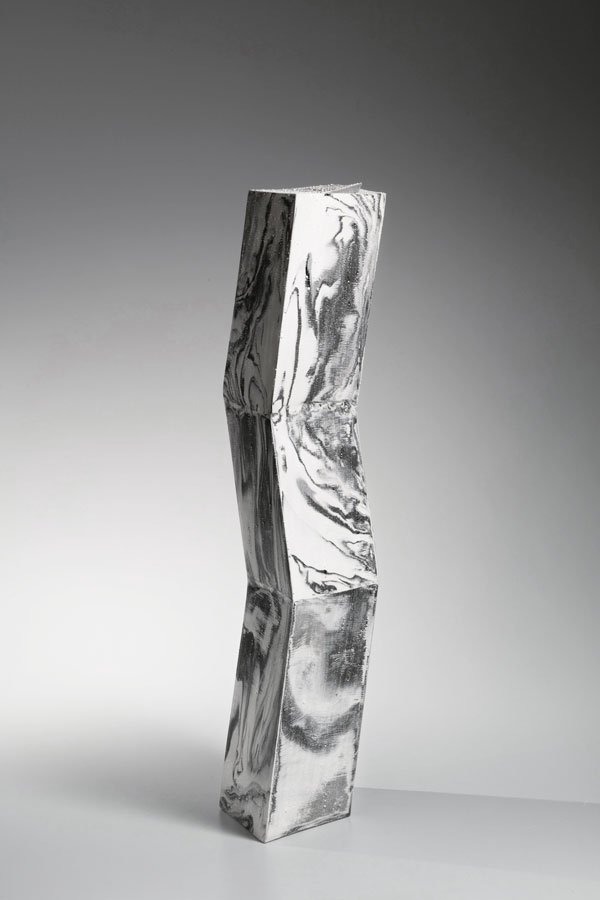
Contemporary Japanese ceramics and contemporary ink paintings will be concurrently exhibited at Joan B Mirviss LTD when Beijing-based gallery INKstudio join forces to present their respective exhibitions: Kondō Takahiro: Making Waves and Bingyi: Land of Immortals. Although their respective media (clay and ink) and artistic forms (sculpture and painting) are vastly different, both artists are deeply engaged with the dynamic forces of nature, specifically, the qualities and behavior of water. When seen together, both artists are clearly engaged in a form of material and artistic transformation that sparks a dialogue about international contemporary art that draws upon and advances traditional East Asian artistic practices. 39 East 78th Street, 4th Floor, Suite 401
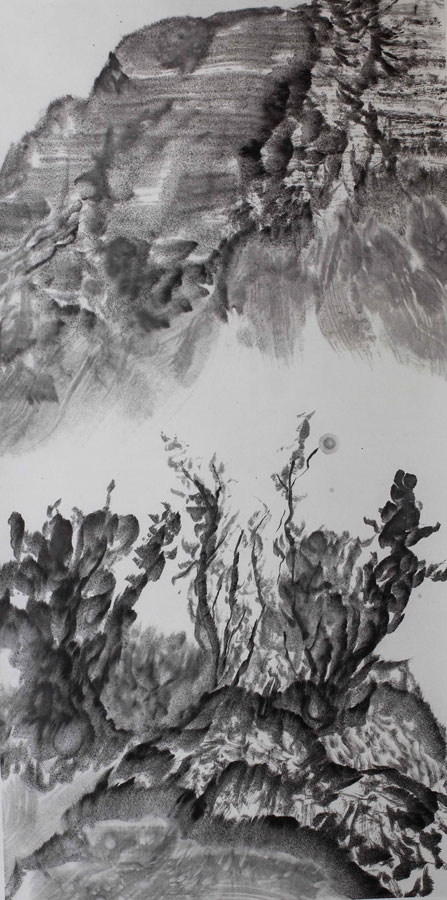
Fu Qiumeng Fine Art makes its Asia Week New York debut with Ink Affinities: The Collaborative Works of Arnold Chang and Michael Cherney. Saltscape Lattice is the artists’ most innovative and experimental of all the works in their exhibition. The "salt print" was one of the earliest processes for producing positive photographic images on a sheet of standard drawing paper; wetting a paper sheet with a salt solution was the first step in making it sensitive to light. As an homage to this process, Cherney photographed salt crystals dissolving under a microscope. When printed, the fractal qualities of the images are enhanced and take on the appearance of rocks, flowers, or other natural forms. By arranging them into the shape of a lattice for printing, Cherney created a “canvas” of random, yet orderly configurations that Morristown, New Jersey based Chang could attempt to weave into a coherent composition. 65 East 80th Street, Ground Floor
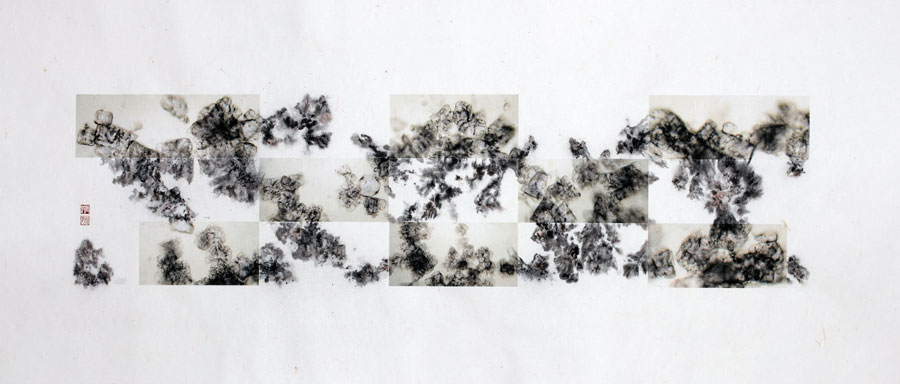
TAI Modern presents Fudo, the intricate work of Yufu Shohaku who was born into a basket making family and was trained in the preparation of bamboo since his youth. A turning point for the young man came when he was studying at a mountain monastery and saw a statue of Fudo Myoo, or Acala, standing in front of a waterfall with a flame on his back, holding a sword and clenching his teeth. The wind was blowing; the trees swayed; the waterfall flowing, but the statue of Fudo Myoo was motionless. Experiencing such a strong presence, he felt the urge to express the power of Acala through his art. After some struggle, he came up with a technique and style that he named ‘dragon pattern,’ which became his signature: a basket that combines the dragon pattern, bamboo rope, and half split chunks of bamboo. 38 East 70th Street
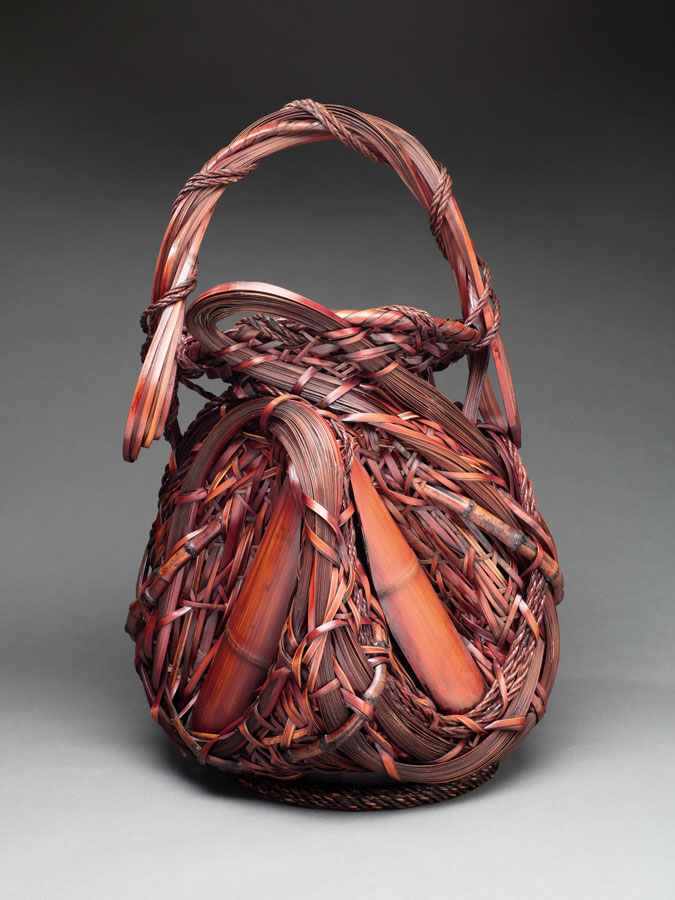
Ippodo Gallery features Kukai’s View; Sun and Moon, Crescent Moon in Chaos to Cosmos, one of the paintings in the solo show of Ken Matsubara. The Kukai series honors sound as it represents eternity, the perfect order of the cycles. As the silver light of the moon shimmers through the darkness, waxing and waning with the sun, so too does the heart and its desires. Matsubara recalls the journey of a Japanese monk (the priestly name is also Kobo or Kobo Daishi). The latter retreated into the caves of Muroto Cape at the Southeastern tip of Shikoku, exiting to behold the breathtaking sun and moon rise in the same place every day against a rocky ocean horizon and a starry sky. Struck by the majesty of their permanence, the monk later named himself ‘Kukai’ (774 – 835), for the ‘air’ (Ku) and ‘sea’ (Kai), completely synonymous with his excursions into nature. His story so resonated with Matsubara that the artist even revisited Kukai’s exact spot to experience the same sensation. 32 East 67th Street, 3rd Floor

Among the contemporary works offered at the Thomsen Gallery is a polished black lacquer box with jelly fish design in gold and silver lacquer by Yoshio Okada. In naming his designs for this series, Okada chose the Chinese characters suigetsu (literally “water moon”) to represent the Japanese word for jellyfish, thus playing with the image of moon light reflecting off jelly fish floating in the ocean.To make distinctions between the boxes in this series—which all have the same distinctive square splayed shape—he selected verbs from ancient poetry with the general meaning of “floating and flickering.” 9 East 63rd Street
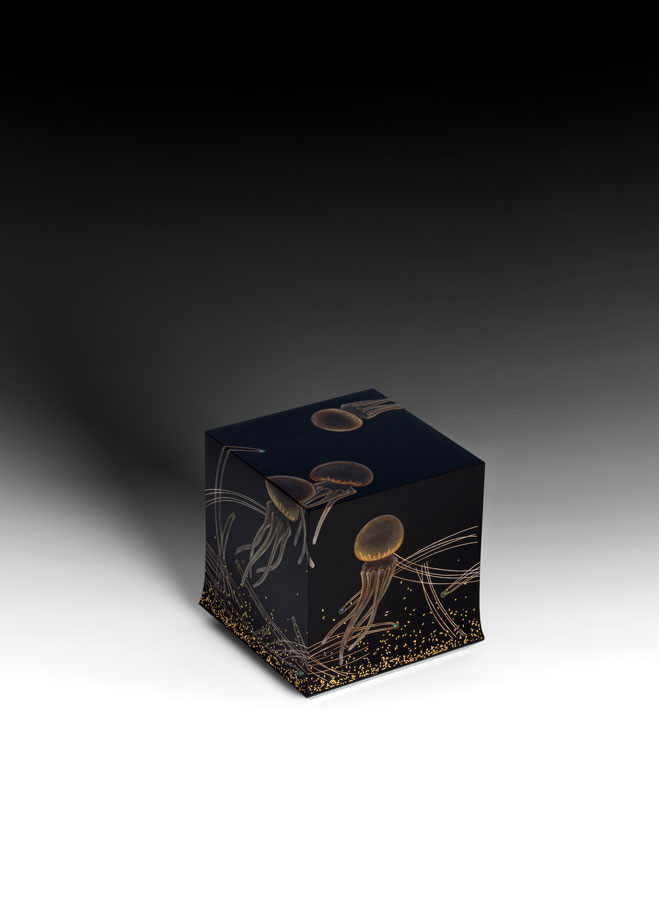
Part of a vanguard generation of highly influential post-war female artists in Japan whose practices are inspired by concepts of female sexuality and representations of nature, Tashima Etsuko’s sculptures–on view at Dai Ichi Arts, Ltd.–bring together two historical craft mediums: glass casting and ceramic sculpture with a yellow oribe underglaze that emphasize the relationship between light shadow and color. Etsuko examines opacity and translucency through materiality while her yellow glazes follow the bold colors that stem from the influence of American expressionism in the 70s, as well as her famous yellow oribe glaze. Tashima’s sculptural forms are streamlined, such as this piece from her Cornucopia series. The glass is cast after the shape of insects’ wings, while the vivid yellow, opaque, biomorphic body has a slight upwards curvature. The name, ’cornucopia’ recalls concepts of natural abundance. 18 East 64th Street

Inspired by nature and the ecology of living things, Onishi Gallery offers this lacquer tea caddy titled Spring Wind, by Murose Kazumi, which illustrates the anticipated transition from winter to spring by depicting flying birds in a windy bamboo grove. Kazumi is a Living National Treasure in the field of maki-e (sprinkled gold on lacquer). 521 West 26th Street

MIYAKO YOSHINAGA presents a single artist show featuring the work of Jonathan Yukio Clark, whose architectural sculpture explores permeable and temporary dividing elements such as windows, sliding doors, and other translucent partitions that frame, view and connect between interiors and exteriors. Light filters through this translucent sculpture made of Japanese paper mounted over an L-shaped wood frame, reminiscent of traditional Japanese shoji screens. The corner piece features a small window as well as inlaid Hawaiian lava rocks – a replica cast from the rock wall surrounding his grandparent’s house. Clark's masterful woodworking technique blends Japanese and Hawaii-native wood, especially the parts regarded as imperfect by the commercial standard. A large rectangular opening reveals the wood surface with natural cracks, contributing to a quietly provoking atmosphere. 24 East 64th Street
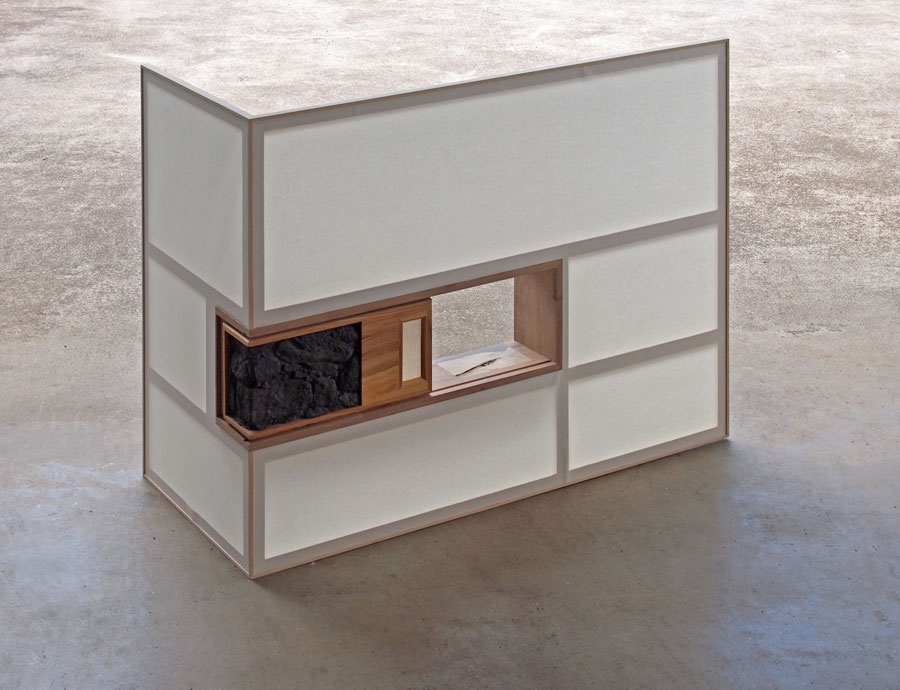
Sea God, by Madhvi Parekh, on view at DAG, is a mesmerizing rendition of the aqueous ecosystem around a sea god, depicted as a powerful, stolid, three-legged being with four ears. The sea deity is surrounded by a tightly packed world of creatures, both land and ocean, going about their lives contentedly as is evident from the smiles on their faces. The Fuller Building, 41 East 57th Street, Suite 708
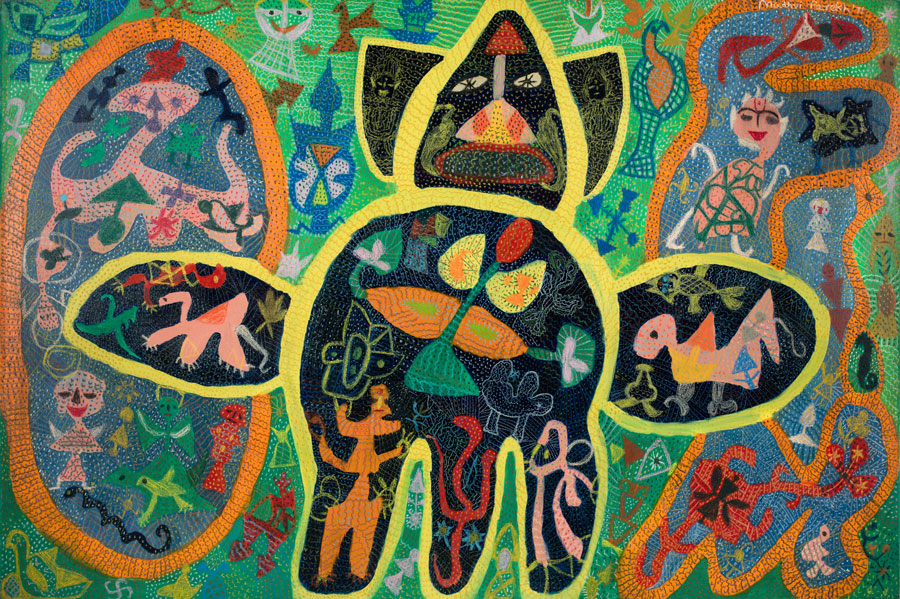
Tonal Dialogue, #10, by Sooyean Hong, is one of the artist’s most recent paintings on view at HK Art and Antiques LLC. This work is a response to her earlier works, which she viewed as hard and compact. In this newer painting, she sought to break apart hard surfaces and freely express herself by using an expanded palette of color. 49 East 78th Street, Suite 4B

About Asia Week New York
The collaboration of top-tier international Asian art galleries, the six major auction houses, Bonhams, Christie’s, Doyle, Heritage Auctions, iGavel, and Sotheby’s, and numerous museums and Asian cultural institutions, Asia Week New York is a week-long celebration filled with a non-stop schedule of simultaneous gallery open houses, Asian art auctions as well as numerous museum exhibitions, lectures, and special events. Participants from Great Britain, India, Italy, Japan, and the United States unveil an extraordinary array of museum-quality treasures from China, India, the Himalayas, Southeast Asia, Tibet, Nepal, Japan, and Korea.
Asia Week New York Association, Inc. is a 501(c)(6) non-profit trade membership organization registered with the state of New York. For more information visit www.AsiaWeekNewYork.com @asiaweekny #asiaweekny
About Songtsam, Presenting Sponsor
Continuing as Presenting Sponsor for Asia Week New York is Songtsam Hotels, Resorts & Tours, an award-winning luxury boutique hotel group with thirteen properties (twelve hotels and one glamping site) located in the Chinese provinces of Tibet and Yunnan.
Founded by Baima Duoji, in 2000, the Songtsam Group is the only collection of luxury Tibetan-style retreats found across the Tibetan Plateau that offers guests sophisticated elegance, refined design, modern amenities, and unobtrusive service in places of natural beauty and cultural interest. With his long-standing and strong interest in Chinese, Himalayan, and Southeast Asian art, Mr. Baima started collecting art long before he established his first hotel, Songtsam Lodge Shangri-La, which is located next to the famous Songzanlin Monastery in Shangri-La. Many of the properties across the Tibetan plateau are decorated with Mr. Baima’s personal collection, with each hotel acting as a private art museum. For more information, visit www.songtsam.com
Captions (top to bottom)
Kondo Takahiro (b.1958)
Nami; “Wave”, 2021
Marbleized porcelain, "silver mist" overglaze
19 3/8 x 9 7/8 x 4 1/2 in. (49.2 x 25 x 11.4 cm.)
Joan B Mirviss LTD
Taihang Rhapsody: Sound of the Empty Valley, 2021
Ink on paper
54 3/8 x 27 1/8 in. (138 x 69 cm.)
INKstudio at Joan B Mirviss LTD
Arnold Chang & Michael Cherney
Saltscape Lattice, 2018
Photography and ink on xuan paper mount on paper
24 x 57 in. (61 x 145 cm.)
Fu Qiumeng Fine Art
Yufu Shohaku
Fudo, 2019
Madake bamboo, bamboo roots & branches
30 x 19 ½ x 19 ½ in. (76.2 x 49.5 x 49.5 cm.)
TAI Modern
Kukai’s View; Sun and Moon, Crescent Moon, 2017
(Set of 4 panes)
71 x 187 x 79 in. (180 × 475 x 200 cm.)
Ippodo Gallery
Yoshio Okada (b. 1977)
“Swimming” Box with Sprinkled Design of Jellyfish, 2020
Maki-e gold lacquer on a wood base
5 ½ x 5 ½ x 5 ½ in. (14.0 x 13.8 x 13.8 cm)
Thomsen Gallery
Tashima Etsuko (b. 1959)
Cornucopia 09-Y12, 2009
Stoneware, glass
8.6 x 16.5 x 14.1 in. (22 x 42 x 36 cm.)
Dai Ichi Arts
Murose Kazumi (b. 1950), Living National Treasure
Tea Caddy Shunpu (Spring Wind), 2017
Lacquered wood, decorated in maki-e with gold powder and mother of pearl inlay
h. 2 1/2 x dia. 3 3/8 in. (6.2 x 8.6 cm.)
Onishi Gallery
Jonathan Yukiko Clark
Untitled (excerpt of a rock wall), 2018
Walnut, sugi, maple, hau, tinted hydrocal, washi
37 x 48 1/2 x 20 1/2 in. (94 x 123.2 x 52.1 cm.)
MIYAKO YOSHINAGA
Madhvi Parekh (b. 1942)
Sea God, 1971
Oil on canvas
48 x 72.2 in. (121.9 x 183.4 cm.)
DAG
Sooyeon Hong (b. 1967)
Tonal Dialogue #10, 2019
Acrylic on canvas
20.9 x 17.9in. (53 x 45.5cm.)
HK Art and Antiques LLC
